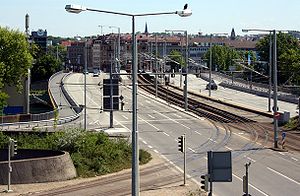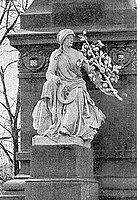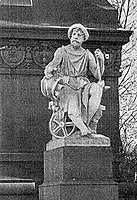King Charles Bridge
Coordinates: 48 ° 47 ′ 59 ″ N , 9 ° 12 ′ 40 ″ E
| King Charles Bridge | ||
|---|---|---|
| King Charles Bridge 2010 | ||
| use | Road bridge, light rail , pedestrian and bike path | |
| Crossing of | Neckar | |
| place | Stuttgart-Bad Cannstatt | |
| construction | 1893: Arch bridge made of Martineisen 1948: Arch bridge made of concrete 1976: Box girder bridge made of steel |
|
| overall length | 252 m | |
| start of building | 1st bridge - 1891 2nd bridge - 1946 3rd bridge - 1970 |
|
| opening | 1st bridge - 1893 2nd bridge - 1948 3rd bridge - 1976 |
|
| planner | 1893: Karl von Leibbrand | |
| location | ||
|
|
||
The König-Karls-Brücke over the Neckar between Stuttgart and Cannstatt was built in 1893. Its architect was Karl von Leibbrand . After the demolition at the end of the war, it was replaced by a concrete arch bridge in 1948 and a steel box bridge in 1976.
The area of the Cannstatter Neckarknies is today as then, with its unique collection of important buildings and leisure facilities ( Wilhelma , Wilhelmatheater, Rosenstein Castle , Rosensteinpark , Villa Berg , Mineralbad Berg , Mineralbad Leuze , Cannstatter Wasen ) the outstanding Neckar section in the Stuttgart region. Important roads already ran here in Roman times and some of the most important traffic arteries in Stuttgart are bundled on this section of the Neckar.
The construction of the new König-Karls-Brücke in the years 1891-1893 was a necessary measure to connect the two rapidly growing cities of Stuttgart and Cannstatt and to cope with the growing volume of traffic. The bridge was celebrated as a masterpiece of engineering, but was largely destroyed in April 1945 and replaced by a new building in 1948. Today there are only two sculptures by the sculptor Adolf Fremd , which were erected on the pylons of the bridge, as well as two undestroyed arches that were used in the reconstruction of the Neckar Bridge in Plochingen.
Planning and construction
The Wilhelmsbrücke , completed by Gottlieb Christian Eberhard von Etzel in 1838, was the only road connection between Stuttgart and Cannstatt or Waiblingen and the Remstal until then . However, the industrialization and growth of the two communities quickly made a better traffic connection necessary, especially since the Wilhelmsbrücke was at risk of flooding. The engineer Karl von Leibbrand , who was commissioned with the planning, carried out the preliminary investigations with regard to costs, geology and hydrology and decided on an arched bridge made of Martineisen with stone pillars. The red sandstone and granite used for this came from the vicinity of Alpirsbach and the Kinzig valley . The Esslingen machine factory supplied the iron superstructure of the bridge.
Construction and destruction
The foundation work for the bridge piers was carried out by Philipp Holzmann & Cie. and Joos & Cie. executed. With the compressed air foundation they used a very advanced method for the time to carry out the difficult work on the pillar foundations. The workers used a helmet diving machine to make the caissons. The King Charles Bridge was inaugurated on September 27, 1893 after a construction period of two years. The costs amounted to 1,300,000 marks. Obviously, this was money well spent, as the König-Karls-Brücke was considered a masterpiece of engineering and attracted attention throughout the German Empire at that time. The bridge was a popular postcard motif and, with the nearby boat rental, a popular weekend destination.
View of the King Charles Bridge with the old Rosenstein Bridge in the background
Sculpture jewelry
The driveways to the bridge were marked by four pylons, which were to be decorated with sculptures. Between 1897 and 1901 the sculptor Adolf Fremd created the allegorical figures "Agriculture", "Commerce", "Industry" and "Wehrstand".
With the construction costs of 1,300,000 marks, however, a total of 30,000 marks were missing for the artistic jewelry. Although the König-Karls-Brücke was celebrated as a masterpiece of the art of bridge construction, several years passed before the decoration with sculptures was completed.
Karl von Leibbrand wanted at least a complete picture of the bridge for the inauguration and commissioned the sculptor Adolf Fremd to create four temporary sculptures. Fremd created the figures in just one week and made them out of plaster, wood and canvas until the opening. Just one day later, on September 28, 1893, the state gazette for Württemberg remarked : "But this outstanding artistic jewelery in particular has so far been a thing of transience and can (...) only survive the winter if it goes well". Although it was quite common at that time to decorate the buildings only after completion, it took the population far too long and the state government acted some criticism. After all, people from all parts of the country flocked to the annual Cannstatter Volksfest . The local press published ridiculous poems, numerous critical articles and asked desperately whether one of the many Stuttgart millionaires would not take pity on one of the sculptures after the government was obviously unwilling to finance it.
The Swabian Kronik asked in February 1896: "For the four figures sitting on the bridge in torn off clothes in storm and weather, day and night, worn clothes and shoes are requested." But the city of Stuttgart and its beautiful neighbor Cannstatt did not hurry either to change this state of affairs, as the Neue Tagblatt noted.
In fact, the decoration of the King Charles Bridge was financed by private individuals. In January 1897, Hermann Werner, owner of the Werner & Pfleiderer company in Cannstatt, made 7,500 marks available for the sculpture "Agriculture". In July, Karl von Leibbrand commissioned Adolf Fremd to execute the figure in "the best white Heilbronn stone". Adolf Fremd was able to convince Karl von Leibbrand to make all sculptures in ivory-colored Kelheim limestone . The Kelheim limestone, also known as "Bavarian marble", harmonized more with the "deep red sandstone" of the bridge. The figure “Handel” was financed in 1898 by a gift from the businessman Heinrich Meyer amounting to 9,000 marks. The positioning of the two figures made the situation worse, however, since the two female figures simply lacked the "men", that is, the counterparts on the opposite pylon. The Neue Tagblatt heard the women complain: "Even one of Stuttgart's millionaires may not give me what I need à tout prix: a man to face-to-face!"
The Cannstatter Zeitung also criticized this in December 1899 and called the incomplete list a real "Swabian coup", but this did not affect the list of the two figures in March 1900. It was not until June of the same year that Adolf Fremd began with the sculpture "Wehrstand" (depicting a Germanic warrior) after the merchant August Scharrer had also promised 9,000 marks to the Mayor of Cannstatt, Oskar Nast . The last figure, “Gewerbe”, was donated by Karl von Leibbrand's daughters, Martha Häbich and Lilli Leibbrand, in memory of their father. It was thanks to private initiative that the state government no longer had to expose itself to the suspicion that it either had no sense or no money for art. Despite his numerous good contacts, Karl von Leibbrand did not manage to find a donor for all sculptures until his death in 1898.
Destruction and rebuilding
Shortly before the end of the war - on April 21, 1945 - the German Wehrmacht blew up two arches of the bridge in order to prevent the advance of the Allied troops. The partial destruction, however, meant the end of what was once “the most beautiful and largest bridge in the country”. As early as October 12, 1945, the State Technical Office commissioned the construction company Karl Kübler to build a provisional King Charles Bridge. The US military pushed for this link to be restored as it was of great importance to a military road network. A wooden nail carrier construction and a steel construction were up for discussion. The commissioned engineers Otto Konz and Prof. Maier-Leibniz had serious reservations about a wooden structure and also rejected the steel structure because of the risk of flooding and ice. A temporary bridge was finally erected near the Berger Steg.
At the same time, the desire for the scarce building materials that the rubble of the destroyed bridge would yield grew. The Motorways Department of the Technical State Office was interested in the intact girders as early as December 1945, as they might still be used as falsework for the restoration of the Franzosenschlucht viaduct. So, while the rubble was being cleared away and not quite sure how to proceed, another idea matured: Dr. At the beginning of January, Fritzsch from the Technical Department of the City of Stuttgart suggested leaving the remaining arches and adding concrete arches and reinforced concrete girders to the bridge. In February 1946, approval was given for the reconstruction of the König-Karls-Brücke. The commissioned companies Wayss & Freytag and Ludwig Bauer started the foundation work just four weeks later.
The old King Charles Bridge was finally completely demolished. Only the stumps of the pillars and the pillars themselves were still there. These were cut and integrated into the new building. The new concrete bridge also had five fields (37, 50, 50, 46, 12 meters), with the new road to Leuzebad and the Cannstatt barrage with the Cannstatt hydropower plant being added. The stitch heights were between 5.20 and 6.20 meters. The total length was 252 meters including the abutments. The width of the previous building was also followed: the carriageway slab was 18 meters wide, only the pedestrians walked on a cantilever three meters wide, in which water and gas pipes were also laid. This part was covered with mastic asphalt, while the actual roadway was made of small pavement. The tram tracks ran in the middle of the bridge during the new construction.
New building
In 1970 the second new construction began as a box girder bridge made of steel, which was completed in 1976. The bridge is now 53 meters wide and 184 meters long.
literature
- Karl Deininger: From the reconstruction of the King Charles Bridge near Stuttgart. In: Bauen und Wohnen , 3rd year 1948, No. 12, pp. 349–358.
- Karl von Leibbrand: The König-Karls-Brücke over the Neckar between Stuttgart and Cannstatt. In: Zeitschrift für Bauwesen , Volume 45, 1895, pp. 61–104. ( online as PDF file; 54.82 MB)
- Jakob Weyrauch : Calculation of the new arch bridge over the Neckar between Stuttgart and Cannstatt. In: Allgemeine Bauzeitung , Volume 60, 1895, p. 49 ff. ( Digitized version )
source
- State Archives Ludwigsburg, Ministerial Department for Road and Hydraulic Engineering, archive unit E 166
Web links
Individual evidence
- ↑ a b Gustav Wais : Stuttgart's art and cultural monuments. 25 pictures with city history, architectural history and art history explanations. Stuttgart 1954.
| Upstream | Crossing the Neckar | Downstream |
| Neckar Valley Viaduct Untertürkheim | King Charles Bridge |
Cannstatt lock |











